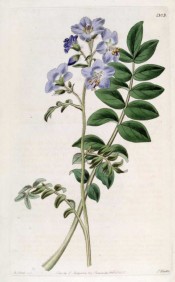Polemonium caeruleum L.
Fully hardy, clump-forming perennial with compound leaves composed of up to 50 lance-shaped leaflets, and terminal or axillary cymes of open bell-shaped, lavender-blue, rarely white, flowers in early summer. To 90cm. [RHSE, Hortus].
Horticultural & Botanical History
An ancient garden plant, grown by John Gerard in 1596 as Greeke Valerian. Johnson’s Dictionary lists five varieties, album; grandiflorum; maculatum, spotted; piliferum Lindl., hairy; and variegatum, variegated leaf, to which Don adds picta, with variegated blue and white flowers and short stems. ‘This plant [the variety piliforum] was raised in the Garden of the Horticultural Society, from seeds collected in the last Arctic Expedition, and presented to the Society by Dr. Richardson.’ [BR f.1303/1830].
History at Camden Park
Listed in the 1845, 1850 and 1857 catalogues [H.185/1845].
Notes
Published Feb 06, 2009 - 04:29 PM | Last updated Jul 29, 2010 - 05:17 PM
| Family | Polemoniaceae |
|---|---|
| Category | |
| Region of origin | Europe, Asia, North America |
| Synonyms | |
| Common Name | Greek valerian, Jacob’s ladder |
| Name in the Camden Park Record | Polemonium caeruleum |
| Confidence level | high |


